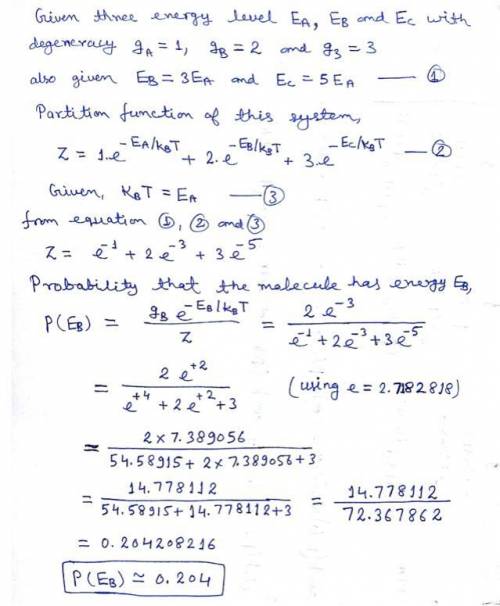
Physics, 16.04.2020 01:07 thomasmurphy200
More than one distinct microstate of a system can have a particular energy (a macrostate). The purpose of this interactive example is to ensure that you know how to deal with this fact when calculating the probability that a small system (here, a molecule) in contact with a thermal reservoir has a particular energy. Let's consider a molecule that can be in one of six microstates. It exchanges energy with a thermal reservoir at a temperature T. One microstate has energy EA, two states have energy EB = 3EA, and three states have energy EC = 5EA. To simplify the numerical calculation, you may assume that the temperature is such that kBT = EA. What is the probability that the molecule has energy EB? P(EB) =

Answers: 3


Other questions on the subject: Physics

Physics, 22.06.2019 10:50, dontcareanyonemo
The temperature at a point (x, y) is t(x, y), measured in degrees celsius. a bug crawls so that its position after t seconds is given by x = 6 + t , y = 8 + 1 3 t, where x and y are measured in centimeters. the temperature function satisfies tx(3, 9) = 5 and ty(3, 9) = 4. how fast is the temperature rising on the bug's path after 3 seconds? (round your answer to two decimal places.)
Answers: 3

Physics, 22.06.2019 12:50, natalyarenassalgado
Arunner is jogging at a steady 3.6 km/hr. when the runner is 2.9 km from the finish line, a bird begins flying from the runner to the finish line at 14.4 km/hr (4 times as fast as the runner). when the bird reaches the finish line, it turns around and flies back to the runner. even though the bird is a dodo, we will assume that it occupies only one point in space, i. e., a zero-length bird. how far does the bird travel? (b) after this first encounter, the bird then turns around and flies from the runner back to the finish line, turns around again and flies back to the runner. the bird repeats the back and forth trips until the runner reaches the finish line. how far does the bird travel from the beginning? (i. e. include the distance traveled to the first encounter)
Answers: 2

Physics, 22.06.2019 20:20, NNopeNNopeNNope
The base of a 50-meter tower is at the origin; the base of a 50-meter tree is at (0, 50, 0). the ground is flat and the z-axis points upward. the following parametric equations describe the motion of six projectiles each launched at time t = 0 in seconds. (i) r (t) = (50 + t2)k (ii) r (t) = 2t2 j + 2t2k (iii) r (t) = 50 i + 50 j + (50 − t2)k (iv) r (t) = 2t j + (50 − t2)k (v) r (t) = (50 − 2t) i + 2t j + (50 − t)k (vi) r (t) = t i + t j + tk (a) which projectile is launched from the top of the tower and goes downward? at time t = , the projectile hits the ground at point (x, y, z) = . (b) which projectile hits the top of the tree?
Answers: 2

Physics, 22.06.2019 20:30, valenzueladomipay09u
Light from two different sources are incident upon the same side of a polarizing filter. light from one source is polarized with total intensity ip, while light from the other source is unpolarized with total intensity iu. as you rotate the polarizing filter through 360 degrees, the intensity of the transmitted light on the other side varies by a factor of 9. what is the relative intensity of the initial polarized source to the unpolarized source, or ip/iu?
Answers: 2
You know the right answer?
More than one distinct microstate of a system can have a particular energy (a macrostate). The purpo...
Questions in other subjects:








Mathematics, 16.01.2020 04:31

Mathematics, 16.01.2020 04:31





